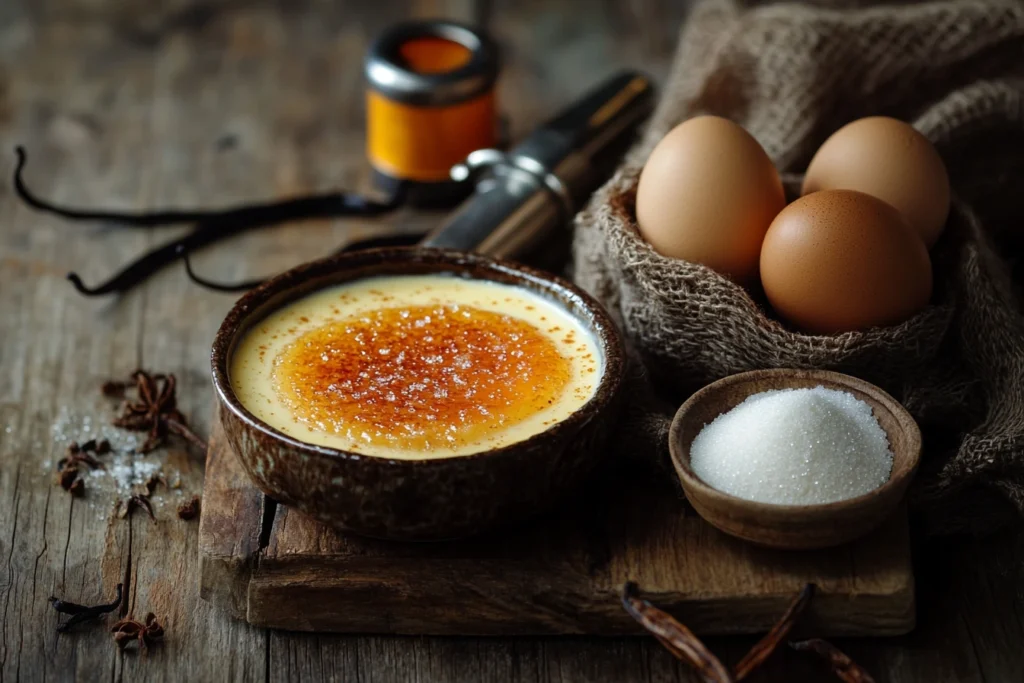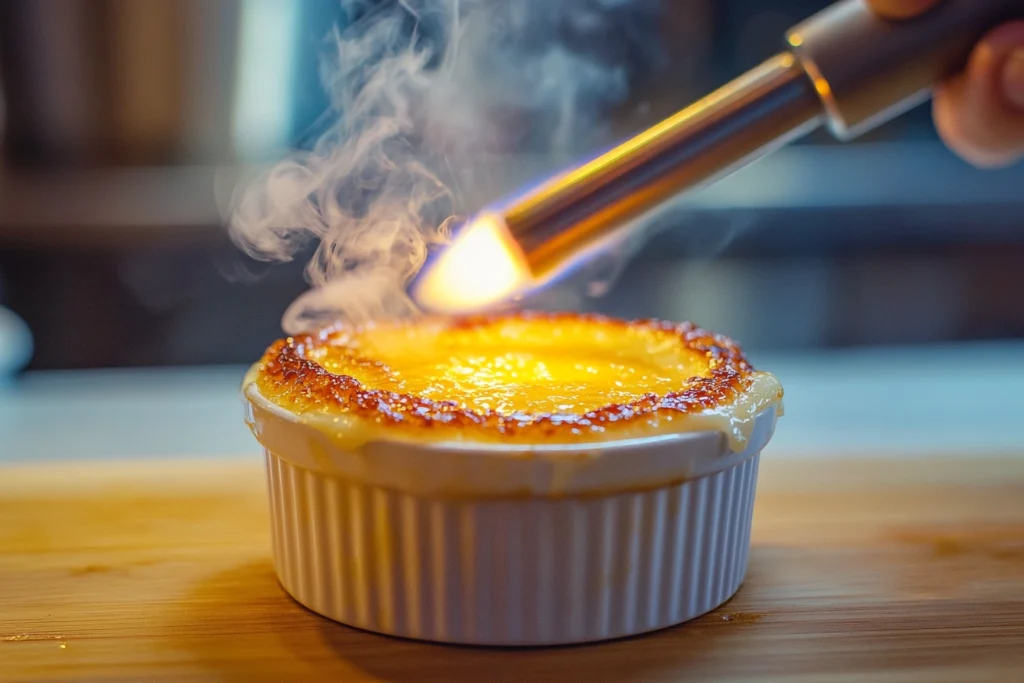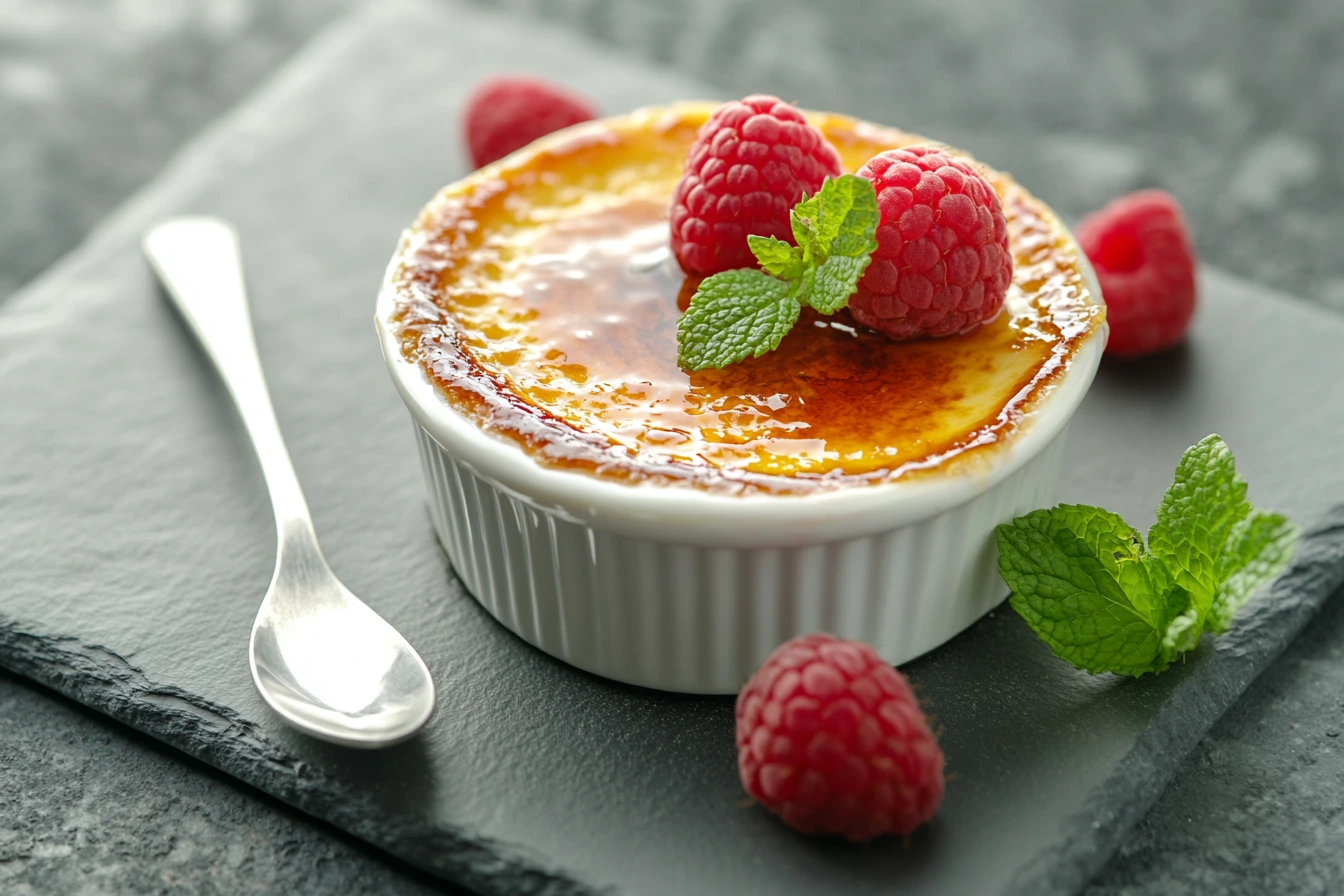What is the secret to crème brûlée? This question has intrigued dessert lovers and home bakers alike for generations. Is it the silky custard base? The perfectly caramelized sugar topping? Or is it something more? The truth is, the secret to crème brûlée lies in a careful balance of ingredients, techniques, and timing.
In this guide, we’ll uncover what the secret to crème brûlée truly is, walking you through each step to master this classic French dessert. From selecting the freshest ingredients to achieving that signature crackly top, you’ll discover the tips and tricks that ensure your crème brûlée is nothing short of perfect.
The Allure of Crème Brûlée
What is the Secret to Crème Brûlée ’s Popularity?
What is the secret to crème brûlée that makes it so beloved worldwide? The answer lies in its harmonious combination of textures and flavors. The creamy, smooth custard paired with the caramelized sugar crust creates a dessert that’s both indulgent and satisfying.
A Classic French Dessert
Crème brûlée has a long history in French cuisine, and its appeal hasn’t waned over the centuries. But what is the secret to crème brûlée ’s timelessness? Simplicity. This dessert uses a few basic ingredients—cream, eggs, sugar, and vanilla—to create something extraordinary.
What is Crème Brûlée?
Definition and Pronunciation
Crème brûlée (pronounced krem broo-lay) is a decadent French dessert that combines a creamy, custard-like base with a crackly, caramelized sugar topping. The name itself, which translates to “burnt cream,” beautifully describes its most iconic feature—the perfectly torched sugar crust that crowns the dessert. The custard is traditionally flavored with vanilla, but subtle variations using fruits or spices have also gained popularity.
Historical Background
The history of crème brûlée is as rich as its flavor. While its exact origins are debated, many credit its roots to 17th-century France. What is the secret to crème brûlée ‘s timelessness? Its simplicity and elegance, which have delighted dessert lovers for centuries.
Key Components of Crème Brûlée
The Silky Custard Base
The heart of any crème brûlée lies in its custard. Made with simple ingredients—heavy cream, egg yolks, sugar, and vanilla—it’s a testament to the magic of simplicity. What is the secret to crème brûlée ’s custard? Precision. The custard must be baked gently in a water bath to ensure a velvety texture that’s creamy yet firm.
The Caramelized Sugar Topping
Ah, the golden crown! Indeed, the caramelized sugar layer is where artistry truly meets flavor. First, a thin layer of sugar is sprinkled evenly over the custard, and then it is caramelized using a kitchen torch or broiler. Consequently, the result is a glass-like shell that shatters delightfully under a spoon, perfectly balancing the creaminess below with a crisp, sweet crunch.
Together, these two components create a dessert that’s simple in its structure but complex in its sensory experience, making crème brûlée the ultimate indulgence.
Essential Ingredients for Crème Brûlée
Crafting the perfect crème brûlée starts with selecting the best ingredients. While the recipe may seem simple, the quality of each component plays a pivotal role in creating the signature flavor and texture that this dessert is known for.

Choosing the Right Cream
The foundation of the custard is heavy cream, which gives crème brûlée its luxurious richness. Opt for high-fat content cream—nothing labeled as “light” or “half-and-half” will do here. The fat not only contributes to the creamy texture but also carries the flavors of vanilla and sugar, ensuring every spoonful is indulgent.
Selecting Quality Vanilla
Vanilla is the soul of crème brûlée. Whether you choose vanilla beans, extract, or paste, make sure it’s of high quality. Vanilla beans are often preferred for their intense aroma and speckled appearance, which adds a touch of elegance. If using beans, scrape out the seeds and infuse them directly into the cream for maximum flavor.
Importance of Fresh Egg Yolks
Egg yolks are what bind the custard together. Fresh, bright-yellow yolks not only enhance the dessert’s texture but also add a natural richness and color. Avoid using pre-separated or powdered eggs, as they lack the depth needed for this delicate dessert.
Sugar Types and Their Roles
Sugar works in two important ways in crème brûlée: not only does it sweeten the custard, but it also forms the caramelized topping. For the custard, granulated sugar dissolves easily and integrates smoothly, ensuring the perfect texture. Meanwhile, for the topping, superfine sugar is ideal because it melts evenly, creating a glassy caramel crust that’s both easy to crack and perfectly balanced in sweetness.
Thus, by thoughtfully selecting these ingredients and using them with care, you effectively set the stage for a crème brûlée that’s restaurant-quality yet made right in your own kitchen.
Mastering the Technique
Perfecting crème brûlée requires more than just the right ingredients—it’s all about the technique. From mixing to baking to that final caramelized touch, every step plays a crucial role in crafting the ideal dessert. Here’s how to master each stage.
Preparing the Custard
Mixing Ingredients to Perfection
The custard starts with careful blending of egg yolks, sugar, and cream. Whisk the yolks and sugar gently until the mixture turns pale yellow and smooth. Over-mixing can introduce too much air, which might result in bubbles or an uneven texture. Gradually add warmed cream to the mixture, tempering the yolks to prevent curdling. This step ensures a silky, cohesive custard base.
Achieving the Ideal Consistency
Strain the custard through a fine-mesh sieve to remove any solids or foam. This step is non-negotiable for achieving that smooth, creamy texture. Aim for a mixture that’s slightly thick but still pourable. The custard should coat the back of a spoon, a classic indicator of readiness.
Baking Methods
The Importance of a Water Bath
The water bath, or bain-marie, is the secret to evenly cooking the custard without curdling or cracking. Place the filled ramekins in a deep baking dish, then pour hot water into the dish until it reaches halfway up the sides of the ramekins. This gentle, moist heat prevents the custard from drying out or overcooking.
Optimal Baking Temperatures and Times
Consistency is key, and baking crème brûlée requires patience. Bake at a low temperature, around 300°F (150°C), for 35–40 minutes or until the custard is set around the edges but still jiggly in the center. Over-baking can lead to a grainy texture, while under-baking may leave the custard too runny.
Caramelizing the Sugar
Using a Kitchen Torch vs. Broiler
Caramelizing the sugar topping is where the dessert earns its name. A kitchen torch is ideal, allowing precise control over the caramelization process. Lightly sprinkle sugar over the cooled custard and apply the flame in sweeping motions to create an even, golden crust. If a torch isn’t available, a broiler can achieve similar results, though it requires careful monitoring to avoid burning the sugar.

Achieving the Perfect Caramel Crust
The caramel crust should be thin enough to crack easily but thick enough to provide that satisfying crunch. For even caramelization, ensure the sugar layer is fine and evenly distributed. Rotate the ramekin as you torch or broil to prevent uneven spots. Once caramelized, let the crust cool briefly before serving for the ultimate textural contrast.
By following these steps, you’ll master the techniques needed to create a flawless crème brûlée every time, from its velvety custard to its signature caramelized topping.
Common Mistakes and How to Avoid Them
Even seasoned bakers can encounter hiccups when making crème brûlée. It’s a delicate dessert that demands precision and patience. However, most common mistakes can be avoided with a few expert tips. Let’s troubleshoot the challenges that can arise during preparation and ensure every batch turns out flawlessly.
Troubleshooting Crème Brûlée
Preventing a Grainy Custard
A grainy custard is often caused by overcooking or overheating the mixture. Custard should be gently baked at a low temperature to maintain its smooth, creamy texture. Using a water bath helps buffer the direct heat and keeps the custard cooking evenly. If the eggs in the mixture start to curdle during preparation, temper the yolks by adding the hot cream gradually while whisking. Skipping this step can result in scrambled eggs rather than a silky custard.
Another key step is straining the custard through a fine sieve before pouring it into ramekins. This removes any tiny lumps and ensures the custard base is perfectly smooth before baking.
Avoiding a Runny Consistency
A custard that doesn’t set properly can be disappointing. The most common culprit is under-baking. Remember that the custard should still jiggle slightly in the center when you remove it from the oven—it will firm up as it cools. Baking at too high a temperature, on the other hand, can also prevent the custard from setting evenly. Stick to the recommended temperature of around 300°F (150°C) and resist the urge to rush the process.
Additionally, ensure the ingredient ratios are correct. Too much cream relative to egg yolks will result in a runny consistency, while too little sugar may prevent the custard from thickening properly.
Ensuring Even Caramelization
Uneven caramelization can detract from the dessert’s signature appeal. To achieve that beautiful, glassy crust, sprinkle the sugar evenly across the surface. Using superfine sugar is ideal, as it melts and caramelizes more uniformly.
When torching, keep the flame moving in steady, sweeping motions rather than focusing on one area for too long. This prevents burning in some spots while leaving others underdone. If using a broiler, position the ramekins close enough to the heat source to caramelize the sugar quickly but not so close that it scorches.
By addressing these common pitfalls, you’ll elevate your crème brûlée from good to extraordinary, ensuring each spoonful delivers a perfect balance of flavors and textures.
Variations and Enhancements
While the classic crème brûlée is undeniably a culinary masterpiece, there’s always room to experiment and add a personal touch. By exploring new flavors or elevating your presentation, you can make this beloved dessert uniquely yours. Let’s dive into some creative twists and tips to enhance your crème brûlée experience.
Flavor Variations
Chocolate Crème Brûlée
For chocolate lovers, this variation is a dream come true. Simply melt high-quality dark chocolate and mix it into the custard base before baking. The result? A rich, velvety custard with the deep, bittersweet notes of chocolate that pair beautifully with the caramelized sugar topping.
Fruit-Infused Options
Fruits add a refreshing twist to this dessert. Infuse the cream with fruit flavors like raspberry, orange zest, or mango by simmering the fruit or zest with the cream and straining before mixing. Alternatively, layer fresh or pureed fruit at the bottom of the ramekins for a hidden burst of flavor with each bite.
Liqueur-Enhanced Versions
Elevate your crème brûlée by adding non-alcoholic extracts, like almond or coffee. Just a teaspoon of a robust flavoring can transform the custard into something extraordinary without overpowering its creamy essence.
Presentation Ideas
Serving in Unique Ramekins
Presentation matters just as much as flavor when it comes to desserts. Serve your crème brûlée in ramekins of various shapes or colors—think heart-shaped dishes for special occasions or rustic ceramic ramekins for a charming, homestyle feel. Clear glass ramekins allow the custard’s creamy layers to shine through, adding a visual treat.
Garnishing Tips
Top your crème brûlée with thoughtful garnishes to enhance its aesthetic appeal. Fresh fruit slices, a sprig of mint, or a dusting of cocoa powder can add a pop of color and flavor. Edible flowers bring a touch of elegance, while a dollop of whipped cream or a delicate chocolate curl can make the dessert even more indulgent.
By experimenting with flavors and refining your presentation, you can create crème brûlée variations that are as stunning as they are delicious. These enhancements ensure that every plate is a feast for the eyes and the taste buds alike.
Frequently Asked Questions
Crème brûlée is a masterpiece of flavor and texture, but crafting it perfectly often raises a few questions. Let’s address these common queries to help you elevate your crème brûlée game.
How to Get the Perfect Crème Brûlée Top?
The hallmark of crème brûlée is its caramelized sugar topping. To achieve perfection, start by sprinkling a thin, even layer of superfine sugar over the chilled custard. Use a kitchen torch to caramelize it, moving the flame in steady, circular motions. This ensures an evenly melted layer that hardens to a crackly crust. If you don’t have a torch, use a broiler, but keep a close eye to prevent burning.
What Makes a Good Crème Brûlée?
A good crème brûlée is all about balance. The custard should be silky and creamy, with just enough firmness to hold its shape. The sugar topping must shatter under the spoon, offering a delightful crunch that contrasts with the soft custard. Additionally, flavors should be harmonious—sweet, rich, and infused with subtle vanilla.
Should You Cover Crème Brûlée in the Fridge?
Yes, you should cover your crème brûlée tightly with plastic wrap before refrigerating. This prevents the custard from absorbing unwanted fridge odors. However, avoid placing anything heavy on top, as this can disturb the smooth surface of the custard. If possible, leave the sugar caramelization for just before serving, as the hardened crust softens over time.
What Is the Best Sugar to Use for Crème Brûlée Topping?
Superfine sugar, also known as caster sugar, is ideal for the topping. Its smaller granules melt quickly and evenly, resulting in a smooth, glass-like crust. Granulated sugar is an acceptable alternative, but avoid coarser sugars, like raw sugar, as they can burn before melting fully.
What Creates the Hard Top on a Crème Brûlée?
The hard top is created by caramelizing sugar through direct heat. When the sugar melts and browns, it forms a glossy, brittle crust. Using a kitchen torch provides precision, but a broiler can also do the job—just make sure to rotate the ramekins for uniform caramelization.
How Hot Should Cream Be for Crème Brûlée?
The cream should be warm but not boiling, ideally around 150°F to 160°F (65°C to 70°C). Heating the cream helps dissolve sugar and infuse vanilla while ensuring the custard mixture blends smoothly without curdling the eggs.
How to Prevent Bubbles in Crème Brûlée?
Bubbles can form if too much air is incorporated during whisking. To prevent this, mix the ingredients gently, avoiding vigorous whisking. Strain the custard through a fine mesh sieve before pouring it into ramekins to remove any existing bubbles. When baking, use a water bath to provide gentle, even heat, which minimizes the risk of bubbles forming.
By following these tips, you’ll gain the confidence to tackle any challenge that comes with making this iconic dessert. With practice, every element of your crème brûlée will be flawless—from the silky custard to the perfect caramel crust.
Conclusion
Mastering crème brûlée is a rewarding journey that combines precision, creativity, and a love for timeless desserts. Whether you’re preparing it for a special occasion or simply indulging your culinary curiosity, this iconic dish never fails to impress.
Recap of Essential Tips
To achieve the perfect crème brûlée, focus on the basics: use high-quality ingredients like fresh cream, egg yolks, and premium vanilla. Pay attention to technique—temper the custard properly, bake gently using a water bath, and caramelize the sugar topping evenly with a kitchen torch. Avoid common pitfalls, like overheating the custard or using the wrong type of sugar, to ensure a smooth, creamy base and that signature crackly crust.

